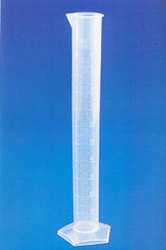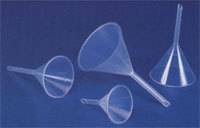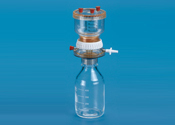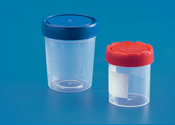BURETTE
BURETTE Specification
- Glass Type
- Borosilicate, Chemically Resistant Glass
- Accuracy
- 0.05 ml
- Power Supply
- Not Required
- Speed Range
- Manual Operation
- Shape
- Cylindrical
- Control Type
- Manual Stopcock
- Display Type
- Graduated Scale (Printed)
- Temperature Resistance
- Up to 200C
- Type
- Graduated Burette
- Dimension (L*W*H)
- Typically 50 cm (length), diameter varies with capacity
- Equipment Materials
- Glass, PTFE (Stopcock)
- Material
- Borosilicate Glass
- Capacity (Ltr)
- 0.05 L (50 ml)
About BURETTE
| BURETTE | ||||||||||||||||
| This Burette has a transparent acrylic body and a leakproof stopcock fitted with a self lubricating PTFE plug. Each burette is individually calibrated to give maximum accuracy. Acrylic body is unaffected by dilute mineral acids & bases except Hydrofloric Acid & Ammonium Hydroxide. The pH range of 1-14 is ideal and can be used up to 5% wt / wt of acids or 30% bases. Material : Polymethyl Metbacrylate / TPX
|
Highly Accurate Chemical Dispensing
This burette is engineered for precise volume measurements, with a fine graduation interval of 0.1 ml and an excellent accuracy of 0.05 ml. The PTFE stopcock ensures drip-free, controlled liquid release, crucial for laboratory titrations and quantitative analysis.
Superior Material and Chemical Resistance
Constructed from borosilicate glass and PTFE, the burette is exceptionally resistant to harsh acids, bases, and solvents. Its durability and temperature resistance (up to 200C) make it ideal for repeated use under demanding laboratory conditions.
User-Friendly, Durable, and Reusable
This burette is designed for ease of use and long service life. It is autoclavable at 121C for effective sterilization and withstands regular cleaning. Its clear markings and straightforward manual operation are suited for both teaching and professional lab environments.
FAQs of BURETTE:
Q: How do I use the burette for titration experiments?
A: Mount the burette securely on a ring stand or clamp, fill it with your titration reagent, and ensure the PTFE stopcock is closed. Read the initial meniscus level, dispense liquid dropwise by turning the stopcock, and monitor the graduated scale to achieve precise volume measurements.Q: What materials make up this burette, and why are they beneficial?
A: This burette is made from chemically resistant borosilicate glass and features a PTFE stopcock. These materials are chosen for their high durability, chemical inertness, and ability to withstand high temperatures, ensuring safety and longevity in laboratory settings.Q: When and where should I autoclave the burette?
A: Autoclave the burette at 121C before and after use in sterile applications or when working with hazardous chemicals. This can be done in a standard laboratory autoclave, ensuring the burette is clean and contamination-free for each use.Q: What chemical solutions can be used with this burette?
A: The burette is compatible with a wide range of chemicals, including acids, bases, and various solvents, due to its borosilicate glass body and PTFE stopcock. Always check the chemicals specific compatibility if using unusually aggressive reagents.Q: Is the burette reusable and how do I clean it?
A: Yes, the burette is fully reusable. To clean, rinse thoroughly with distilled water after each use. For stubborn residues, use appropriate laboratory detergents compatible with glass and PTFE. The burette can withstand regular cleaning and sterilization processes.Q: What are the benefits of the PTFE stopcock compared to glass or other material stopcocks?
A: PTFE stopcocks provide superior chemical resistance, smoother operation, and leak-free control compared to glass or plastic alternatives. They reduce the risk of reagent contamination and make precise manual adjustment easier.Q: How accurate is this burette and how is volume measured?
A: The burette offers a graduation interval of 0.1 ml and delivers an accuracy of 0.05 ml. The volume dispensed is measured using the clearly printed blue graduations, ensuring high precision during laboratory analyses.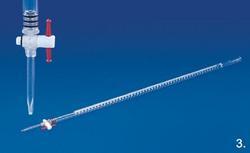

Price:
- 50
- 100
- 200
- 250
- 500
- 1000+
More Products in POLYLAB PLASTICWARE Category
MEASURING CYLINDER PENTAGONAL
Type : Other, Measuring Cylinder Pentagon Shape
Shape : Pentagon
Application : Laboratory Liquid Measurement
Material : High Quality Transparent Glass
Equipment Materials : Borosilicate Glass
FUNNELS - LONG STEM
Type : Other, Long Stem Funnel
Shape : Conical with long cylindrical stem
Application : Laboratory liquid transfers, filtration
Material : Glass
Equipment Materials : Borosilicate Glass
Features : Long stem for precise pouring; chemical resistance; autoclavable
Resuable Bottle Top Filter
Type : Reusable Bottle Top Filter, Other
Shape : Cylindrical
Application : Laboratory Filtration
Material : Borosilicate Glass Polypropylene
Equipment Materials : Borosilicate Glass Polypropylene
Features : Reusable Durable Easy to Clean
Sample Container
Type : Sample Container, Other
Shape : Round
Application : Sample collection and storage
Material : Polypropylene
Equipment Materials : Polypropylene
Features : Leakproof lid Transparent body Available in different capacities
GST : 06ACOPS0805K1ZD
|
 |
SINGHLA SCIENTIFIC INDUSTRIES
All Rights Reserved.(Terms of Use) Developed and Managed by Infocom Network Private Limited. |


 Send Inquiry
Send Inquiry
